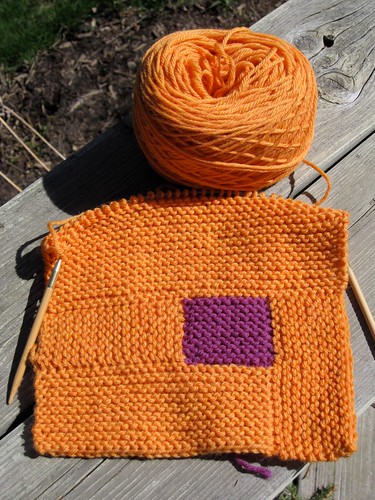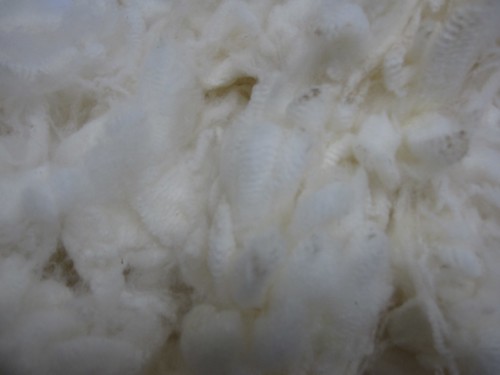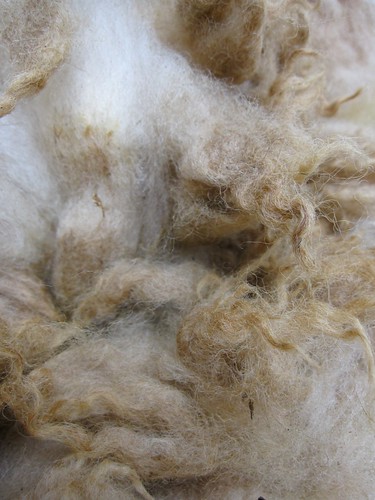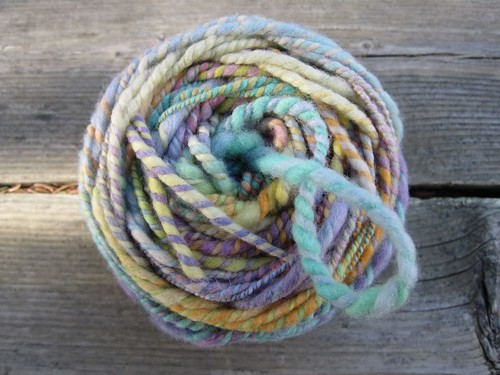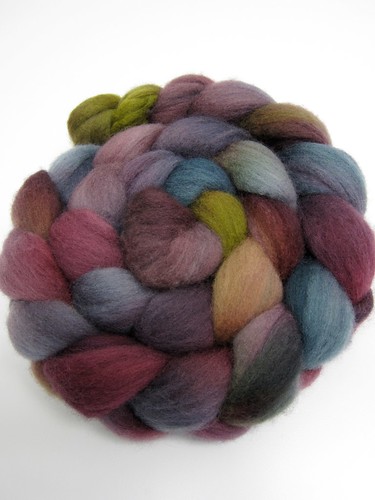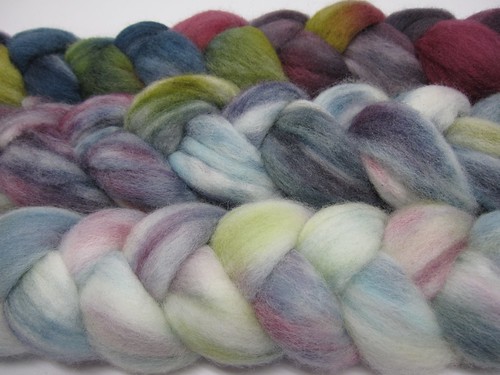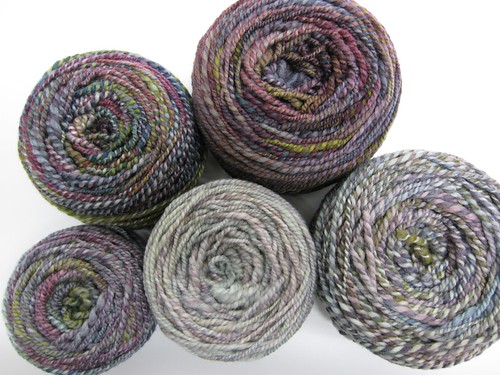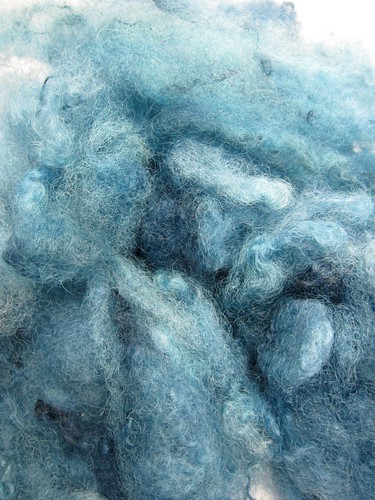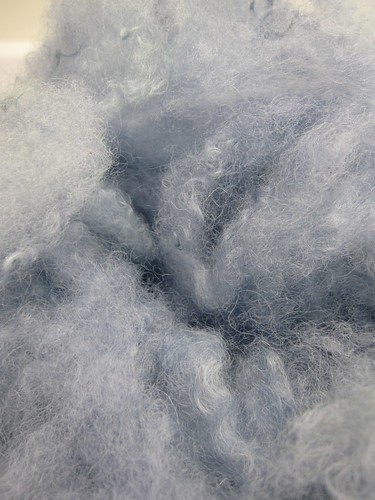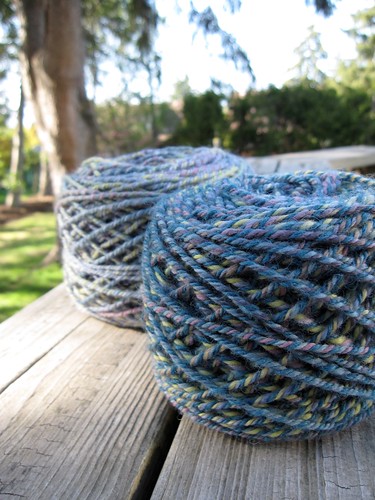Thursday, April 29, 2010
In which the Rabbit confesses her adoration of Kay Gardiner
The Rabbit just loves Kay Gardiner, the "Mason" half of Mason-Dixon Knitting.
I adore her affection for the rectilinear, the clean-lined, and the graphic. I swoon over her passion for garter stitch, and her brilliance in deploying it in ever-new ways. And I totally heart the fact that she hearts the quilts of Gee's Bend. So, inspired by her fabulously cukoo-for-coco-puffs plan to knit an entire log-cabin afghan out of sock yarn, I have embarked on a log cabin project of my own (first, experimental square, above). Partly because I want to use up all that Cascade 220 I bought for the Penny Rug Purse that got frogged when the color decisions all got too much for me. But mostly because I want to be more like Kay Gardiner.
Here are some things of hers that I particularly love. Most of the postings on Mason-Dixon Knitting don't seem to have their own links, so you'll have to search for these: "A Dingo Stole My Baby," and "Blue, Orange, Green, Green, Green, White, White, White, White." The latter I find heartbreakingly gorgeous.
Saturday, April 24, 2010
In which the Rabbit ponders her ambivalence about processing fleece
The Rabbit is amassing something of a history with fleece. Raw fleece, right (more or less) off the sheep, skirted—that is, with all the really filthy bits removed—but still all greasy and smelly and delightfully sheepy.
I love raw fleece. But here's what's a little weird: once I've washed it, I kind of lose interest. Because once it's washed, it—and I—enter a space not unlike the waiting place in Dr. Seuss' Oh, The Places You'll Go. The Carding Place. Or, in some cases, the Combing Place. In either case, a place one has to be for a very long time. And the fact is, I don't care much for these places.
My drumcarder has helped. It's a Strauch Petite, and it makes big, lovely batts. But not everything is suitable for drumcarding.
This big, beautiful Cormo fleece (above) that I bought in the fall from Sue Reuser is too fine for the drumcarder; it needs to be combed by hand. Somehow, I find the prospect of combing a five-pound fleece kinda daunting. And I haven't even started it. Even though the fleece is to die for.
On the other hand, the drumcarder is perfect for this little beauty:
This is a two-pound (manageably sized!) fleece from a California Red lamb. It's from Elizabeth and Leonard Ferraro at Apple Rose Farm, and I think I got it within a week or two of shearing. Because it's a lamb's fleece, it's soft, and the color variation in the lock makes a lovely, tweedy, oatmeal-colored yarn.
The plan was that the California Red fleece was going to be a sweater for Mr. Rabbit. But I'm not sure that I have enough of it. So I've arranged to buy a big Corriedale fleece (seven pounds) from Windborne Farm that will become Mr. Rabbit's sweater. But I'm getting smarter in my old age. I'm going to pick up the fleece next week at the Maryland Sheep and Wool Festival, and then I'm going to trundle it right over to Zeilinger's Wool Co. and give it to them for washing and processing into roving.
Thus completely avoiding The Carding Place.
I love raw fleece. But here's what's a little weird: once I've washed it, I kind of lose interest. Because once it's washed, it—and I—enter a space not unlike the waiting place in Dr. Seuss' Oh, The Places You'll Go. The Carding Place. Or, in some cases, the Combing Place. In either case, a place one has to be for a very long time. And the fact is, I don't care much for these places.
My drumcarder has helped. It's a Strauch Petite, and it makes big, lovely batts. But not everything is suitable for drumcarding.
This big, beautiful Cormo fleece (above) that I bought in the fall from Sue Reuser is too fine for the drumcarder; it needs to be combed by hand. Somehow, I find the prospect of combing a five-pound fleece kinda daunting. And I haven't even started it. Even though the fleece is to die for.
On the other hand, the drumcarder is perfect for this little beauty:
This is a two-pound (manageably sized!) fleece from a California Red lamb. It's from Elizabeth and Leonard Ferraro at Apple Rose Farm, and I think I got it within a week or two of shearing. Because it's a lamb's fleece, it's soft, and the color variation in the lock makes a lovely, tweedy, oatmeal-colored yarn.
The plan was that the California Red fleece was going to be a sweater for Mr. Rabbit. But I'm not sure that I have enough of it. So I've arranged to buy a big Corriedale fleece (seven pounds) from Windborne Farm that will become Mr. Rabbit's sweater. But I'm getting smarter in my old age. I'm going to pick up the fleece next week at the Maryland Sheep and Wool Festival, and then I'm going to trundle it right over to Zeilinger's Wool Co. and give it to them for washing and processing into roving.
Thus completely avoiding The Carding Place.
Thursday, April 22, 2010
In which the Rabbit considers the mysteries of dyeing
For the past few months, the Rabbit has been experimenting with dyeing fiber, and trying to learn about what fiber dyed in particular ways looks like when it is spun into yarn. There has been a lot of brightly-colored paw fur and some interesting results.
For example, this is some of the first fiber I dyed, with food coloring from the local Metro. It's hard to get much depth of shade with food coloring, so the fiber ended up looking like Easter eggs. Which, if you're a rabbit, isn't such a bad thing, as Easter is the national holiday of bunnies. Anyway, here's some fiber from that experiment, some Cormo top from Apple Rose Farms:
See what I mean about Easter eggs? So here's what that top looks like as yarn:
I found it hard to draft the Cormo smoothly, so I went for a thick and thin yarn. This was before I read Judith McKenzie McCuin on thick and thin yarn, so the bumps aren't exactly mathematically precise. But I still think this would make a nice baby hat.
For my second experiment, I used acid dyes (Sabraset, to be exact, from Pro Chemicals) on some lovely Polwarth top from Legacy Studio:
At the time, I was deep into Lynne Vogel's Twisted Sisters Sock Workbook. I highly recommend this book to anyone interested in dyeing fiber. Vogel keeps the math involved in mixing dye solutions very simple, and advocates just mixing colors intuitively and playing, which gave me the courage to dive in.
I used the same four colors, a persian blue, an olive, an eggplant and a plum using different dyeing methods on different sections of fiber. I was thus able to get a range of different values that I then combined in different ways (still following Lynne Vogel's advice). Here was the result:
The braid in the back was painted in solid stripes; for the ones in the front, I scattered the dye onto the fiber in artful, Pollock-esque drips (the difference between the front and middle braids was only in how much dye I used).
I then made a series of two-ply yarns using these braids in as many different combinations as I could.
Then I became interested in what happens when one uses one solid ply and two painted plies together in the same yarn. I started with this Finn top, from Village Spinning and Weaving, dyed with Sabraset dyes:
Then I dyed up some border leicester locks in coordinating blues:
and
Spun and plied together, these yarns look like this:
Finally, and this will catch you all up on the dyeing experiments thus far, yesterday I dyed three 3 oz. bumps of Wensleydale (from the fabulous Beth Smith's Spinning Loft) in tones of red, green and brown, with one light bump, one medium, and one dark. I used the same base color for the browns, adding black for the darkest bump and water for the lightest. I aimed for a forest, olive and sage green, and for a maroon, medium red and a pink for the other two. Things turned out unexpectedly:
Not exactly what I was going for, but I'm going to try plying them together and see what happens.
For example, this is some of the first fiber I dyed, with food coloring from the local Metro. It's hard to get much depth of shade with food coloring, so the fiber ended up looking like Easter eggs. Which, if you're a rabbit, isn't such a bad thing, as Easter is the national holiday of bunnies. Anyway, here's some fiber from that experiment, some Cormo top from Apple Rose Farms:
See what I mean about Easter eggs? So here's what that top looks like as yarn:
I found it hard to draft the Cormo smoothly, so I went for a thick and thin yarn. This was before I read Judith McKenzie McCuin on thick and thin yarn, so the bumps aren't exactly mathematically precise. But I still think this would make a nice baby hat.
For my second experiment, I used acid dyes (Sabraset, to be exact, from Pro Chemicals) on some lovely Polwarth top from Legacy Studio:
At the time, I was deep into Lynne Vogel's Twisted Sisters Sock Workbook. I highly recommend this book to anyone interested in dyeing fiber. Vogel keeps the math involved in mixing dye solutions very simple, and advocates just mixing colors intuitively and playing, which gave me the courage to dive in.
I used the same four colors, a persian blue, an olive, an eggplant and a plum using different dyeing methods on different sections of fiber. I was thus able to get a range of different values that I then combined in different ways (still following Lynne Vogel's advice). Here was the result:
The braid in the back was painted in solid stripes; for the ones in the front, I scattered the dye onto the fiber in artful, Pollock-esque drips (the difference between the front and middle braids was only in how much dye I used).
I then made a series of two-ply yarns using these braids in as many different combinations as I could.
Then I became interested in what happens when one uses one solid ply and two painted plies together in the same yarn. I started with this Finn top, from Village Spinning and Weaving, dyed with Sabraset dyes:
Then I dyed up some border leicester locks in coordinating blues:
and
Spun and plied together, these yarns look like this:
Finally, and this will catch you all up on the dyeing experiments thus far, yesterday I dyed three 3 oz. bumps of Wensleydale (from the fabulous Beth Smith's Spinning Loft) in tones of red, green and brown, with one light bump, one medium, and one dark. I used the same base color for the browns, adding black for the darkest bump and water for the lightest. I aimed for a forest, olive and sage green, and for a maroon, medium red and a pink for the other two. Things turned out unexpectedly:
Not exactly what I was going for, but I'm going to try plying them together and see what happens.
In which the Rabbit makes a recommendation
Subscribe to:
Posts (Atom)
